Prove \(AECF\) is a parallelogram.
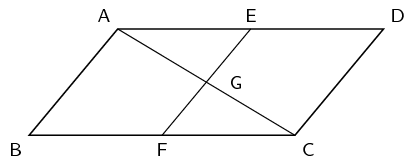
\(AC\) and \(EF\) bisect each other (given).
\(AECF\) is a parallelogram (diagonals bisect each other).
|
Previous
End of chapter exercises
|
Next
12.2 Chapter summary
|
Geometry (from the Greek “geo” = earth and “metria” = measure) arose as the field of knowledge dealing with spatial relationships. Geometry can be split into Euclidean geometry and analytical geometry. Analytical geometry deals with space and shape using algebra and a coordinate system. Euclidean geometry deals with space and shape using a system of logical deductions.
We will now apply what we have learnt about geometry and the properties of polygons (in particular triangles and quadrilaterals) to prove some of these properties. We will also look at how we can prove a particular quadrilateral is one of the special quadrilaterals.
This video shows how to prove that the the diagonals of a rhombus are perpendicular.
In parallelogram \(ABCD\), the bisectors of the angles (\(AW\), \(BX\), \(CY\) and \(DZ\)) have been constructed. You are also given \(AB=CD\), \(AD=BC\), \(AB\parallel CD\), \(AD\parallel BC\), \(\hat{A}=\hat{C}\), \(\hat{B}=\hat{D}\). Prove that \(MNOP\) is a parallelogram.
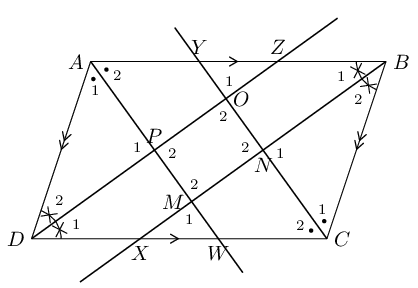
In \(\triangle CDZ\) and \(\triangle ABX\),
\[\begin{array}{rll} D\hat{C}Z& = B\hat{A}X & \text{ (given)}\\ {\hat{D}}_{1} & = {\hat{B}}_{1} & \text{ (given)} \\ DC & = AB & \text{ (given)} \\ \therefore \triangle CDZ & \equiv \triangle ABX & \text{ (AAS)} \\ \therefore CZ & = AX & \\ \text{and } C\hat{Z}D & = A\hat{X}B & \end{array}\]In \(\triangle XAM\) and \(\triangle ZCO\)
\[\begin{array}{rll} X\hat{A}M & = Z\hat{C}O & \text{(given: } \triangle CDZ\equiv \triangle ABX\text{)} \\ A\hat{X}M & = C\hat{Z}O & \text{ (proved above)} \\ AX & = CZ & \text{(proved above)} \\ \therefore \triangle XAM & \equiv \triangle ZCO & \text{ (AAS)} \\ \therefore {\hat{M}}_{1} & = {\hat{O}}_{1} & \\ \text{but }{\hat{M}}_{1} & = {\hat{M}}_{2} & \text{(vert opp }\angle \text{s } = \text{)}\\ \text{and }{\hat{O}}_{1} & = {\hat{O}}_{2} & \text{(vert opp } \angle \text{s } = \text{)}\\ \therefore {\hat{M}}_{2} & ={\hat{O}}_{2} \end{array}\]First show \(\triangle ADW\equiv \triangle CBY\). Then show \(\triangle PDW\equiv \triangle NBY\).
Both pairs of opposite angles of \(MNOP\) are equal. Therefore \(MNOP\) is a parallelogram.
This video shows how to prove that the opposite angles of a parallelogram are equal.
In the diagram below, \(AC\) and \(EF\) bisect each other at \(G\). \(E\) is the midpoint of \(AD\), and \(F\) is the midpoint of \(BC\).
Prove \(AECF\) is a parallelogram.

\(AC\) and \(EF\) bisect each other (given).
\(AECF\) is a parallelogram (diagonals bisect each other).
Prove \(ABCD\) is a parallelogram.
\(AD \parallel BC (AE \parallel CF, ~ AECF\) is a parallelogram)
\(AD = 2AE\) (mid-point, given)
\(CF = AE\) (\(AECF\) is a parallelogram)
\(\therefore AD = 2AE = 2CF = BC\)
\(ABCD\) is a parallelogram (two sides are parallel and equal)
Parallelogram \(ABCD\) and \(BEFC\) are shown below. Prove \(AD = EF\).
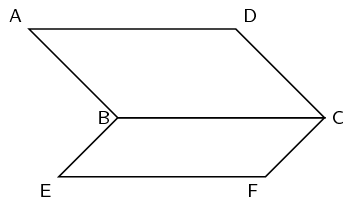
\(PQRS\) is a parallelogram. \(PQ=TQ\). Prove \(\hat{Q_1} = \hat{R}\)
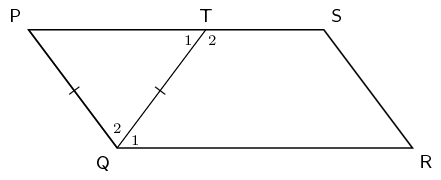
Study the quadrilateral \(ABCD\) with opposite angles \(\hat{A} = \hat{C} = 108^{\circ}\) and angles \(\hat{B} = \hat{D} = 72^{\circ}\) carefully. Fill in the missing reasons and steps to prove that the quadrilateral \(ABCD\) is a parallelogram.
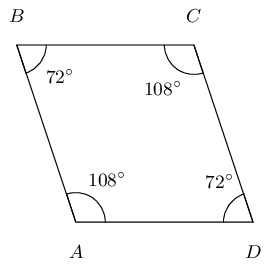
Here is the completed proof with the correct steps and reasons.
\[\begin{array}{|l |l|} \hline \text{Steps} & \text{Reasons} \\ \hline B\hat{A}D = B\hat{C}D & \text{given both } \angle\text{'s } = 108^\circ \\ A\hat{B}C = A\hat{D}C & \text{given both } \angle\text{'s } = 72^\circ \\ \hat{A} + \hat{B} + \hat{C} + \hat{D} = 360 ^\circ & \text{sum of } \angle \text{s in quad} \\ B\hat{A}D + A\hat{D}C = 180 ^\circ & \text{given } 108^\circ + 72^\circ = 180^\circ \\ \therefore AB \parallel DC & \text{co-int } \angle \text{s; } AB \parallel DC \\ \therefore BC \parallel AD & \text{co-int } \angle \text{s; } BC \parallel AD \\ \therefore ABCD \text{ is a parallelogram} & \text{opp sides of quad } \parallel \\ \hline \end{array}\]Study the quadrilateral \(QRST\) with opposite angles \(Q = S = 124^{\circ}\) and angles \(R = T = 56^{\circ}\) carefully. Fill in the missing reasons and steps to prove that the quadrilateral \(QRST\) is a parallelogram.
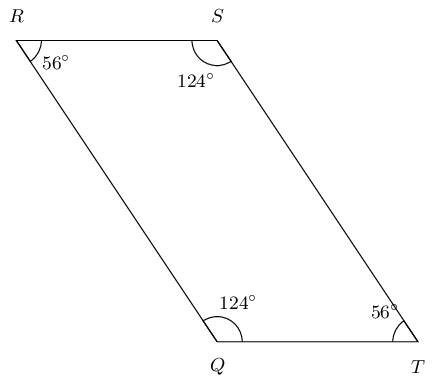
Here is the completed proof with the correct steps and reasons.
\[\begin{array}{|l |l|} \hline \text{Steps} & \text{Reasons} \\ \hline R\hat{Q}T = R\hat{S}T & \text{given both } \angle\text{s } = 124^\circ \\ Q\hat{R}S = Q\hat{T}S & \text{given both } \angle\text{s } = 56^\circ \\ \hat{Q} + \hat{R} + \hat{S} + \hat{T} = 360 ^\circ & \text{sum of } \angle \text{s in quad} \\ R\hat{Q}T + Q\hat{T}S = 180 ^\circ & \text{given } 124^\circ + 56^\circ = 180^\circ \\ \therefore QR \parallel TS & \text{co-int } \angle \text{s; } QR \parallel TS \\ \therefore RS \parallel QT & \text{co-int } \angle \text{s; } RS \parallel QT \\ \therefore QRST \text{ is a parallelogram} & \text{opp sides of quad } \parallel \\ \hline \end{array}\]Quadrilateral \(QRST\) with sides \(QR \parallel TS\) and \(QT \parallel RS\) is given. You are also given that: \(\hat{Q} = y\) and \(\hat{S} = 34^{\circ}\); \(Q\hat{T}R = x\) and \(R\hat{T}S = 41^{\circ}\). Prove that \(QRST\) is a parallelogram.
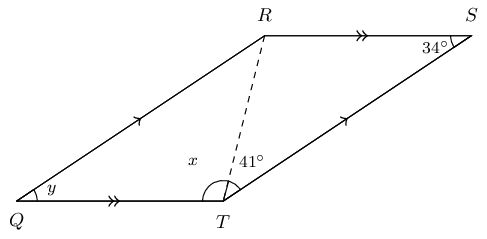
Find the value of \(y\).
\(QRST\) is a parallelogram (proved above).
\(\hat{Q} = \hat{S}\) and \(\hat{R} = \hat{T}\) (opp \(\angle\)s of \(\parallel\)m).
Therefore, \(y = 34^{\circ}\).
Find the value of \(x\).
We can solve this problem in two ways: using the sum of angles in a triangle or using the sum of the interior angles in a quadrilateral.
Option 1: sum of angles in a triangle.
\(\hat{Q} + Q\hat{R}T + Q\hat{T}R = 180 ^{\circ}\) (sum of \(\angle\)s in \(\triangle\)).
We know that \(\hat{Q} = \hat{S} = 34^{\circ}\) and that \(R\hat{T}S = 41^{\circ}\).
\(\therefore x = 180^{\circ} - 34^{\circ} - 41^{\circ} = 105^{\circ}\).
Option 2: sum of angles in a quadrilateral.
The sum of the interior \(\angle\)'s in a quadrilateral is \(360 ^{\circ}\).
\begin{align*} \therefore \hat{Q} + \hat{R} + \hat{S} + \hat{T} & = 360 ^{\circ} \quad \text{(sum of }\angle \text{s in quad}\\ 34^{\circ} + 34^{\circ} + \hat{R} + \hat{T} & = 360^{\circ} \\ \hat{R} & = \hat{T} \quad \text{ opp } \angle \text{s of }\parallel\text{m)} \\ 68^{\circ} + 2\hat{R} & = 360^{\circ} \\ \hat{R} & = \frac{292}{2} \\ & = 146^{\circ} \\ x & = 146^{\circ} - 41^{\circ} = 105^{\circ} \end{align*}Quadrilateral \(XWVU\) with sides \(XW \parallel UV\) and \(XU \parallel WV\) is given. Also given is \(\hat{X} = y\) and \(\hat{V} = 36^{\circ}\); \(X\hat{U}W = 102^{\circ}\) and \(W\hat{U}V = x\). Prove that \(XWVU\) is a parallelogram.
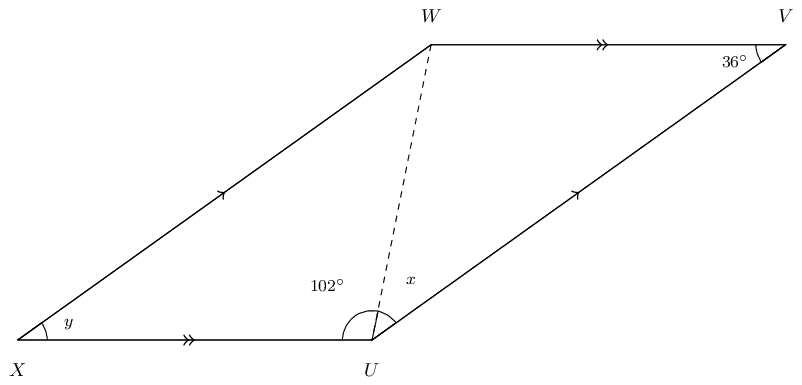
Determine the value of \(y\).
\(XWVU\) is a parallelogram, \(\therefore \hat{X} = \hat{V}\).
Opposite \(\angle\)'s of a parallelogram are equal: \(\hat{X} = \hat{V}\) and \(\hat{W} = \hat{U}\).
Therefore, \(y = 36^{\circ}\).
Determine the value of \(x\).
We can solve this problem in two ways: using the sum of angles in a triangle or using the sum of interior angles in a quadrilateral.
Option 1: sum of angles in a triangle.
\(\angle\)'s in a \(\triangle = 180 ^{\circ}\)
\(\therefore \hat{X} + X\hat{W}U + X\hat{U}W = 180 ^{\circ}\)
Now we know that \(\hat{X} = \hat{V} = 36^{\circ}\) and that \(X\hat{U}W = 42^{\circ}\).
\(\therefore \hat{x} = 180^{\circ} - 36^{\circ} - 102^{\circ} = 42^{\circ}\).
Option 2: sum of interior angles in a quadrilateral.
The sum of the interior \(\angle\)'s in a quadrilateral is \(360^{\circ}\).
\begin{align*} \therefore \hat{X} + \hat{W} + \hat{V} + \hat{U} & = 360 ^{\circ} \quad \text{(sum of }\angle \text{s in quad}\\ 36^{\circ} + 36^{\circ} + \hat{U} + \hat{W} & = 360^{\circ} \\ \hat{U} = \hat{W} & \quad \text{ opp } \angle \text{s of }\parallel\text{m)} \\ 72^{\circ} + 2\hat{U} & = 360^{\circ} \\ \hat{U} & = \frac{298}{2} \\ & = 149^{\circ} \\ x & = 149^{\circ} - 102^{\circ} = 42^{\circ} \end{align*}In parallelogram \(ADBC\), the bisectors of the angles \((A, D, B, C)\) have been constructed, indicated with the red lines below. You are also given \(AD = CB\), \(DB = AC\), \(AD \parallel CB\), \(DB \parallel AC\), \(\hat{A} = \hat{B}\) and \(\hat{D} = \hat{C}\).
Prove that the quadrilateral \(MNOP\) is a parallelogram.
Note the diagram is drawn to scale.
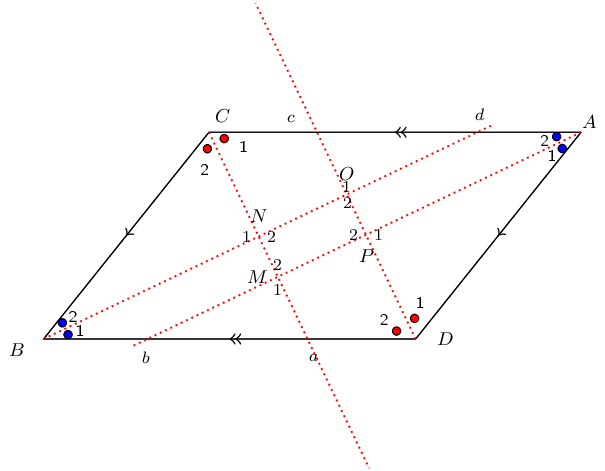
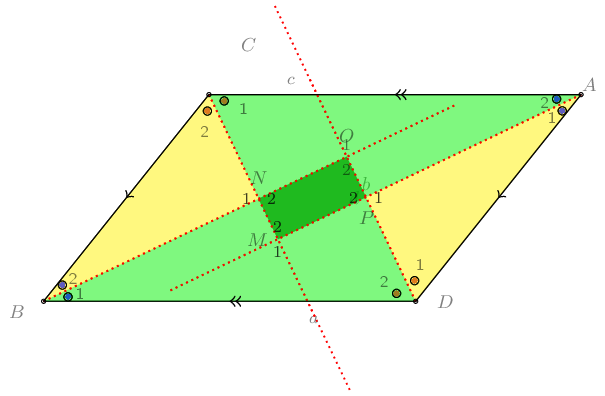
Study the diagram below; it is not necessarily drawn to scale. Two triangles in the figure are congruent: \(\triangle QRS \equiv \triangle QPT\). Additionally, \(SN = SR\). You need to prove that \(NPTS\) is a parallelogram.
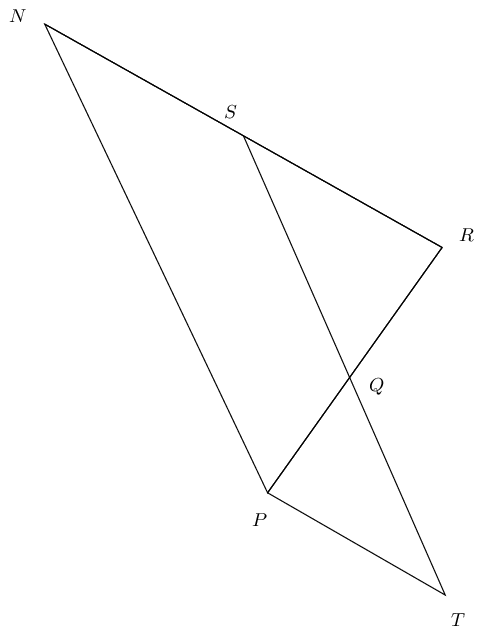
Redraw the diagram and mark all given and known information:
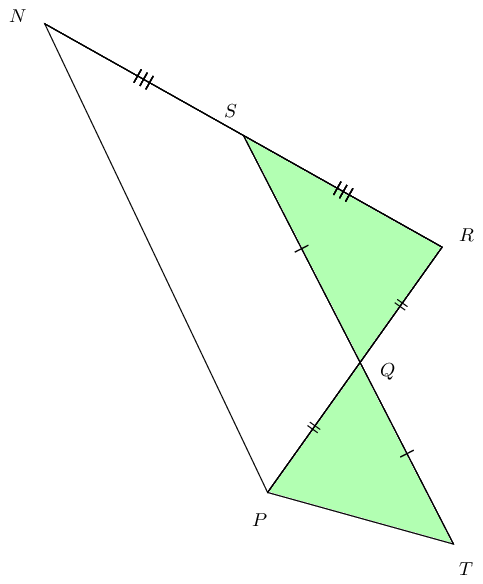
Study the diagram below; it is not necessarily drawn to scale. Quadrilateral \(XWST\) is a parallelogram and \(TV\) and \(XW\) have lengths \(b\) and \(2b\), respectively, as shown. You need to prove that \(\triangle TVU \equiv \triangle SVW\).

Redraw the diagram and fill in all given and known information.
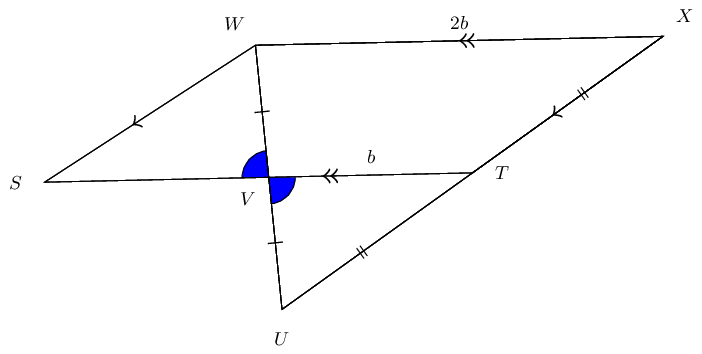
\(T \text{ and } V \text{ are mid-points}\)
\[\begin{array}{|l | l|} \hline \text{Steps} & \text{Reasons} \\ \hline WV = VU & \text{definition of mid-point} \\ T\hat{V}U = S\hat{V}W & \text{vert opp } \angle \text{s} = \\ TV + VS = XW & \text{opp sides parm are equal} \\ b + VS = 2b & \text{substitute given values: } TV = b \text{ and } XW = 2 b \\ VS = b = VT & \text{solve for } VS; \text{ note that it is equal to } VT \\ \triangle TVU \equiv \triangle SVW & \text{SAS} \\ \hline \end{array}\]|
Previous
End of chapter exercises
|
Table of Contents |
Next
12.2 Chapter summary
|